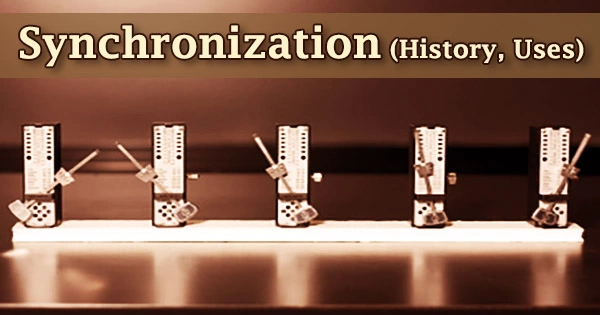For consistent results, synchronization is designed to be cooperative, requiring that every thread follow the synchronization method before accessing protected resources. It is the synchronization of events that allows a system to function as a whole. The conductor of an orchestra, for example, maintains the symphony in sync or in time.
Synchronization, in a traditional sense, refers to the adjustment of the rhythms of self-sustained periodic oscillators due to their weak interaction; this adjustment is defined in terms of phase-locking and frequency entrainment. One of the most common natural phenomena is synchronization, which occurs when two or more events occur at the same moment.
Satellite navigation signals and other time and frequency transfer techniques can now be used to synchronize systems all across the world. Data streams are received and delivered accurately, and data collision is avoided, thanks to synchronization between network nodes.
To maintain proper signal timing, it commonly uses a clock signal delivered in tandem with a data stream. Synchronization in vast ensembles of coupled systems frequently manifests as collective coherent regimes arising from non-equilibrium phase transitions.
It is quite worth noting that when we suspended two clocks so constructed from two hooks imbedded in the same wooden beam, the motions of each pendulum in opposite swings were so much in agreement that they never receded the least bit from each other and the sound of each was always heard simultaneously.
Christiaan Huygens
The history of synchronization can be traced back to the 17th century when the famed Dutch scientist Christiaan Huygens reported on the synchronization of two pendulum clocks he had invented just a few years previously:
“It is quite worth noting that when we suspended two clocks so constructed from two hooks imbedded in the same wooden beam, the motions of each pendulum in opposite swings were so much in agreement that they never receded the least bit from each other and the sound of each was always heard simultaneously.”
“Further, if this agreement was disturbed by some interference, it reestablished itself in a short time. For a long time I was amazed at this unexpected result, but after a careful examination finally found that the cause of this is due to the motion of the beam, even though this is hardly perceptible.”
Lord Rayleigh described another key observation of organ pipe synchrony in his “Theory of Sound.” Synchronization, arguably the oldest scientifically investigated nonlinear process, was only fully grasped in the 1920s, when E. V. Appleton and B. Van der Pol explored synchronization of triode electronic generators in a systematic theoretical and experimental manner.
Synchronization is the coordination of multiple threads or processes in computer science (particularly parallel computing) to accomplish a task in the correct runtime order with no unanticipated race situations; see synchronization (computer science) for more information. It allows you to share resources like file processing, network connections, and memory by coordinating threads and processes to prevent data corruption.
The word is used in the context of multithreaded systems, where the resources that must be shared between numerous threads must be managed, otherwise, an unforeseen and unwanted outcome can occur. When numerous interacting dynamical systems have independent oscillators, synchronization can occur. Model systems that can interact and partially synchronize inside random or regular networks are known as Poincaré phase oscillators.
Life requires synchronization as well. To guarantee that our hearts beat properly, pacemaker cells, for example, must fire electrical discharges synchronously. When the coupling strength crosses a crucial threshold in global synchronization of phase oscillators, a sudden change from unsynchronized to full synchronization occurs.
For consistent results, synchronization is designed to be cooperative, requiring that every thread follow the synchronization method before accessing protected resources. In inert systems, physicists are particularly interested in synchronization. When numerous generators are connected to an electrical grid, alternator synchronization is essential in electric power networks.
Noise has little effect on synchronization effects. The impact of a tiny noise on a synchronous state usually results in the occurrence of phase slips, which are quite uncommon. To ensure that the receiving cipher decodes the proper bits at the right time, most encryption schemes require some sort of synchronization mechanism. Some systems may only be plesiochronous, or roughly synced.
















